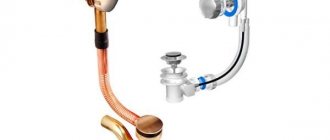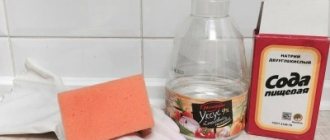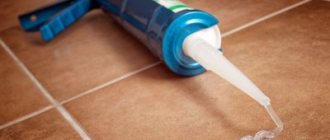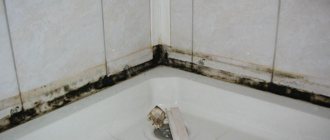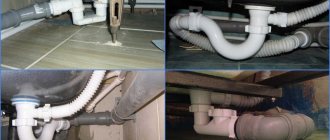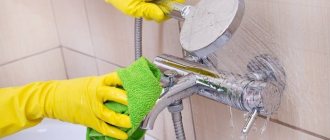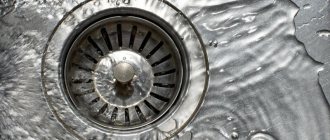Step-by-step instructions for using a sewer plunger
If too much water has accumulated in the toilet, scoop out the excess - the remaining volume should cover the rubber “bowl” of the plunger.
Before cleaning the sink or bathtub, close the overflow holes with plugs (in extreme cases, plug them tightly with a rag). The following algorithm of actions is suitable for cleaning any plumbing fixtures: If too much water has accumulated in the toilet bowl, scoop out the excess - the remaining volume should cover the rubber “bowl” of the plunger. Before cleaning the sink or bathtub, close the overflow holes with plugs (in extreme cases, plug them tightly with a rag). The following algorithm of actions is suitable for cleaning any plumbing fixtures:
- Place the plunger as tightly as possible against the drain hole.
- As a rule, water “stands” in clogged plumbing fixtures. If it is not enough to completely cover the plunger nozzle (and therefore create the required pressure), add the required amount.
- If the nozzle does not “stick”, lubricate the edges with Vaseline.
- Without moving or moving the plunger, apply firm pressure to the handle several times. The “sucking” sound is a sign that you are doing everything right. To clean a toilet or bathtub with a plunger, several “approaches” of 3-5 strong pushes are enough.
- After you have gotten rid of the garbage plug, clear the hole of any floating debris and run hot water over the pipes for 5-10 minutes. If the toilet is clogged, flush the water several times and pour a bucket of hot water down the drain.
Content
A plunger is a device consisting of two elements: a rubber cup-shaped attachment and a wooden or plastic handle.
The principle of operation of the device is based on the destruction of the plug under the pressure created in the system when pumping with a plunger.
Cleaning the sink with a plunger is the most gentle way to break up a dirt plug without using caustic chemicals and mechanical damage to the internal walls of the pipeline.
Mechanical plungers designed for cleaning sinks are available in two versions:
- with a dense rubber nozzle shaped like a washer;
- with an elastic cone-shaped nozzle.
Depending on the shape of the nozzle, you can obtain different degrees of compression on the unit being cleaned.
The model with a cone-shaped nozzle promotes better adhesion of the edges to the drain hole
Advice: to effectively use the device, when choosing a product, you should focus on the diameter of the drain hole of the plumbing equipment.
Separately, it is worth highlighting pneumatic plungers. Outwardly, they resemble pumps, with a capacity of 1-2 liters, equipped with rubber tips.
The nozzle of the pneumatic device ensures a tight fit of the device’s pump nozzle to the surface of the plumbing.
Although these devices are classified as professional equipment, even amateurs can easily use them.
Toilet plungers also have cone-shaped attachments, but with a larger diameter. The volume of the body of these products can reach 1 dm 3.
To clean toilets, devices with a bowl diameter of 10 cm are most often used.
Tip: When clearing a clogged toilet using a plunger, it is not uncommon for the rubber part of the tool to get stuck in the drain hole receiver. To prevent this, additionally fasten the elements of the device by nailing the bowl to the handle.
The pneumatic model differs from its counterpart intended for a bathtub or sink only in the diameter and shape of the nozzle. There are universal models on sale that come with a set of suction cups. By changing the nozzles, you can clean both toilet drains and sinks or showers.
Before using the plunger in the sink, you must tightly close the overflow hole.
Closing the drain hole will prevent a decrease in pressure on the stuck dirt plug.
The instructions for using a tool to clear a clog in a sink or bathtub are quite simple:
- The sink or bathtub is emptied of excess liquid, leaving a small amount only near the drain hole.
- The tool is installed so that the rubber nozzle completely blocks the drain hole.
- By pressing on the cap, perform several active pumping motions, after which the device is abruptly removed.
- If used correctly, small pieces of dirt will begin to appear from the hole along with the drains. At this moment, the nozzle is moved to the side, allowing the drain to fill with water, and, without waiting for the liquid to drain again, it is pumped again.
- If the stagnant water does not fall into the drain hole, repeat the procedure.
- After making sure that the plug is destroyed, rinse the drain hole with hot water.
Using a pneumatic plunger in a sink is not much more difficult. The procedure is performed in the following sequence:
- Collect water into the pump container by immersing the device in a filled bucket or under a water tap.
- Plug all nearby drain and overflow holes with plugs.
- Having connected the nozzle of the device to the drain hole, press it firmly so that it fits tightly to the surface.
- With a sharp movement, the piston is pushed into the container of the device, pushing the water out of the pump.
- If the plug does not collapse under the influence of a strong flow of water, the procedure must be repeated.
- At the end of the procedure, the drain is washed with a stream of hot water.
Title[edit | edit code]
Comes from fr. ventouse, originally meaning "medicine glass jar". The word was borrowed in the 13th century from medical Latin: lat. ventosa - medical jar, lit. "inflated" < lat. ventus - wind. At the beginning of the 19th century, this word began to have figurative meanings: leeches, as well as the respiratory organs of some animals, began to be called this way. In the 20th century, the name was transferred to rubber caps capable of being pressed tightly against a flat surface under air pressure.
The stress in a French word is on the last syllable. Some dictionaries indicate the pronunciation of plunger
[2].
What does a regular plunger consist of?
Regardless of the type, a plunger, as a rule, consists of only two elements:
- Handles for a comfortable grip;
- And from a special cup-shaped nozzle, which is most often made of rubber.
A plunger is a technical device, a valve for automatically removing air that accumulates at the highest points of plumbing, heating and similar systems.
Advantages and disadvantages of using a plunger
You can consider the obvious advantages that a plunger provides in comparison with many other methods of clearing clogs:
- Its exceptional low cost;
- Extreme simplicity of design - thanks to which the plunger can fail after a very long time, even under intensive use;
- Easy to use;
- Effective for most types of blockages;
- In this case, there is practically no risk of damaging the toilet bowl or sink, as well as the surface of the pipe.
However, the plunger also has some disadvantages:
- Sometimes it is necessary to make a noticeable effort in order to clear too “stubborn” blockages;
- There is a possibility of spilling the contents of the toilet or sink if used too intensively;
- Although it works with most blockages, it does not work with all;
- Most effective for blockages located near the drain hole. The farther the blockage is located from it, the lower the efficiency.
A plunger is a suction cup attached to a wooden or plastic handle. It removes blockages by hydraulic shock against the blockage, pushing it through and destroying it.
Video
Technique for cleaning a bathtub drain with a plunger:
This article was produced by our experienced team of editors and researchers, who reviewed it for accuracy and comprehensiveness.
Number of sources used in this article: 13. You will find a list of them at the bottom of the page.
wikiHow's content management team carefully monitors the work of its editors to ensure that every article meets our high quality standards.
A plunger is an inexpensive and effective tool that is essential in every home as it is used to clear blocked pipes. If your toilet, sink, or bathtub won't drain water, a plunger can usually fix the problem in a few minutes. At the same time, you should use the right methods so that your actions bring results.
Preventing sink clogging
- After each dishwashing, take the time to clean the siphon of any remaining food and grease. You don't have to disassemble it. Just open the hot water for half a minute. That's all!
- A clog in the sink or an unpleasant smell from the sewer in the kitchen will not bother you if you do weekly preventive maintenance. Mix citric acid, salt and baking soda in a ratio of 0.5:1:1. Pour the mixture down the drain and add one part boiling water. Within 5 minutes, the solution should clear the pipe walls of plaque. Rinse with water.
- The drains can be cleaned of soap residues and grease deposits once a week with plenty of boiling water. Pour a large pot of boiling water into the sink and wait 5 minutes. After this, use a plunger. Flushing with hot water prevents all sorts of nasty things from accumulating in the siphon and on the pipes.
- Most importantly, do not throw leftover food, coffee or tea down the sink. Or use a special mesh that is inserted into the drain hole and collects debris. All that remains is to clean it from dirt after washing the dishes. That's all!
It's better to prevent a problem than to fight it
Yes, if a person regularly prevents blockages, he will avoid many troubles. What should you do for this? First, you need to install a protective mesh at the water drain hole: it will protect the pipes from dirt, animal hair, and hair getting into them. Secondly, chemicals are considered a good means of prevention - the main thing is to use them in accordance with the instructions so as not to damage the pipes. In general, proper operation and timely preventive measures extend the service life of communications, ensure their reliability and prevent blockages.
We hope that the information presented in this publication will help you solve the problem of how to remove a clog in the bathroom. And also, remember that the best way to remove blockages is preventive measures. By performing them, you can be sure that unnecessary discomfort will not be created in the bathroom and you will not have to use a plunger or plumbing cable.
Chemicals are faithful helpers
How to remove a blockage in the bathroom using drain cleaning products and which product should you prefer?
As for the first point, there is nothing complicated here: I bought a cleaning product in a specialized store, read the instructions carefully and did everything in accordance with the written information. This is important to know: the product is poured or poured into the sewer hole, left there for a while, and then thoroughly washed off with running water.
In addition, we would like to draw your attention to the fact that chemicals must be used correctly, since even the safest drugs, when used for a long time, cause deformation of the material from which the pipes are made.
Chemicals are effective, but using them too often will damage your pipes.
When deciding how to break through a clog in the bathroom, modern people are faced with another problem, because there is a wide range of cleaning products on the market. Therefore, we should name the most popular drugs to make the choice easier for our readers:
- “Mole” is an effective remedy that cannot be used on plastic pipes;
- "Mr. Muscle" is a product suitable for all types of pipes. It is available in the form of a gel or foam. "Mr. Muscle" cleans pipes of dirt, penetrating into all nooks and crannies. It also kills bacteria, thereby helping to eliminate odor;
- "Tiret" - removes blockages quickly and effectively. It does not smell of ammonia and, according to user reviews, does its job perfectly;
- “Pothan” is a substance that quickly and without residue dissolves various contaminants. It has a sharp chemical smell, but it breaks through even the most severe blockages.
When using products for cleaning clogs, you need to remember safety precautions, that is, when working with alkalis and acids, you should be properly equipped.
This means wearing rubber gloves, safety glasses and an oilcloth apron.
Plumbing cable - a more serious method of cleaning
Everyone understands perfectly well that using a plunger can only clear minor blockages, so it is necessary to consider other methods of dealing with this nuisance.
The plumbing cable must be kept taut when clearing the blockage.
If the blockage is located far in the pipe or it is strongly compressed, they resort to cleaning using a cable. The essence of this method is that you need to hook the debris with a plumbing cable, pulling it out or pushing it into a wider pipeline.
This procedure proceeds as follows:
- the cable is inserted into the drain hole;
- one person pushes the cable, and the other rotates it;
- after passing through the clogged area, you need to make a couple of sharp jerks back and forth, then open the hot water tap and carefully pull out the cable to wash off the dirt that has formed in the sewer pipe.
It is worth paying attention: rotating the cable helps to better destroy the blockage.
Plumbing cable is sold at a hardware store, but you can make it yourself. To do this, you need to take a piece of a fairly flexible metal cable, bend it and fluff the tip a little. Thanks to this manipulation, the cable will move well along the bends of the pipe and will not rest against the knee.
This is important to know: for ease of grip, the cable should be wrapped in something rigid to form a kind of handle.
It is also necessary to mention the fact that a plumbing cable should absolutely not be used to clean plastic, chrome-plated pipes - then their inner surface can be damaged.
Preventing blockages
So that the system does not have to be constantly broken, it is necessary to follow the basic rules for using sewer communications.
- Only flush liquid waste into the toilet.
- Ensure that the amount and size of waste corresponds to the traffic capacity of the installed equipment.
- Promptly and thoroughly sanitize the toilet. If the toilet is not cleaned for a long time, or the cleaning is not deep enough, this leads to the formation of urinary stones on the walls, which subsequently leads to low patency of the pipes.
- At least several times a year you need to use special products, the action of which is aimed at breaking down organic particles and fats settling on the walls of the bathroom.
- Constantly talk to children about not throwing solid objects down the toilet.
- It is advisable to flush the system with hot water every few days.
- An effective preventive method is baking soda in combination with vinegar.
( 2 ratings, average 4.5 out of 5 )
Measures to prevent contamination in the bath
D»Ã ÃÂþóþ ÃÂÃÂþñàÿÃÂõôþÃÂòÃÂðÃÂøÃÂàà·Ã°Ã³ÃÂÃÂ÷ýõýøõ ò ÃÂûøòõ ÃÂðúþòø ýàøûø òðýýÃÂ, ýõþñÃÂþô øüþ ÃÂôõûøÃÂàòÃÂõüàÿÃÂþÃÂøûðàºÃÂøÃÂõÃÂúøü ÿÃÂþÃÂõôÃÂÃÂðü. ÃÂàòÃÂÿþûýõýøõ ýõ ÿþÃÂÃÂõñÃÂõà üýþóþ òÃÂõüõýø, ð ÃÂÃÂõôÃÂÃÂòð, à All rights reserved. , ýðùôÃÂÃÂÃÂàò úðà¶Ã´Ã¾Ã¼ ôþüõ.
çÃÂþñàòþôþÿÃÂþòþôýÃÂõ ÃÂÃÂÃÂñàýõ ÷ðóÃÂÃÂ÷ýÃÂûøÃÂàþÃÂÃÂþôðüø, ø ýõ ÿþÃÂòøûþÃÂàÃÂøÃÂÃÂðÃÂø ø, úþóôð òþôð ÿûþÃÂþ ÃÂÃÂþôøÃÂ, ýõþñÃÂþôøüþ ÷ðúÃÂÃÂòðÃÂàÃÂûøòà VALUE ûÃÂýÃÂüø ÃÂõÃÂúðüø ôûà÷ðÃÂøÃÂÃÂ. › õàüøýøüø÷øÃÂþòðÃÂàÿþÿðôðÃà½Ã¸Ãµ ÃÂðÃÂÃÂøÃÂõú ÿøÃÂø ø ôÃÂÃÂóøàþÃÂóðýøÃÂõÃÂúøà þÃÂÃÂþôþò ò ÃÂûøò.
- ðÃÂÃÂòþÃÂÃÂÂàýðúþÿøòÃÂøùÃÂàüàÃÂþàÃÂûõôÃÂõàýõ ÃÂõöõ ÃÂð÷ð ò üàµÃÂÃÂÃÂ. The ºÃ¾Ã³Ã´Ã° ÷ðÃÂþÃÂàõÃÂõ ýõ ÃÂûøÃÂúþü à òþôõ ø òþôð › ÂøÃÂ. âðúðàÿÃÂþÃÂõôÃÂÃÂð ÃÂñõÃÂõöõàþà þñÃÂð÷þòðýøàÿÃÂþñþú. ÃÂÃÂþòþôøÃÂàõõ üþöýþ àÿþüþà VALUE ð÷øýõ (ÃÂÃÂþÃÂ, âøÃÂõàâÃÂÃÂñþ ภÃÂ. ô.).
- GALA µ ÿõÿðÃÂðÃÂÃÂ,àüþöõàþñÃÂÃÂýÃÂù ÿà ôûàÃÂÃÂøÃÂúø. ÃÂûàÿÃÂþÃÂøûðúÃÂøúø ÷ðÃÂþÃÂþò ý õþñÃÂþôøüþ ÷ðúÃÂÃÂòðÃÂàÃÂûøòýà VALUE ¸Ã½Ã ÃÂð÷ ò 4âÂÂ5 üõÃÂÃÂÃÂõò. › › õù òþôþù. ÃÂþ ÿÃÂþÃÂõÃÂÃÂòøø 5 üøýÃÂàÿÃÂþÃ±Ãºà ¸ ýÃÂöýþ òÃÂýÃÂÃÂÃÂ. ÃÂÃÂþàÃÂÿþÃÂþñ ÃÂðúöõ ÿþüþöõàà VALUE ¿Ã°ÃÂð ø÷ ÃÂûø òð.
- ÃÂûàÃÂþóþ ÃÂÃÂþñà÷ðÃÂþÃÂàôþûóþ à ÿþÃÂòûÃÂûøÃÂÃÂ, üþöýþ ÿÃÂþûøààÃÂûøòýþõ þÃÂòõÃÂÃÂÃÂøõ úøÿ ÃÂÃÂúþü ø÷ ÃÂðùýøúð. › »ÃµÃ´ÃÂõàò ÃÂõÃÂõýøõ 2âÂÂ3 üøýÃÂÃÂ.


